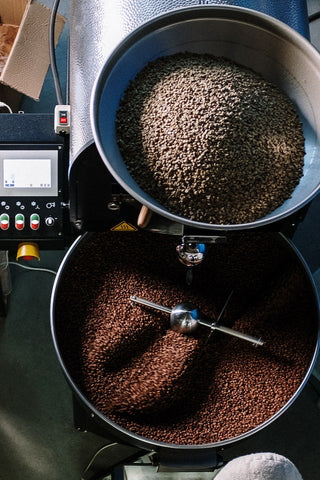The transformation of green coffee beans into roasted, ready-to-drink coffee may seem like a simple process. In reality, there are many more layers and variables at play. We'll examine coffee roasting in great detail, from A to Z:
A - Arabica: Arabica is the most common coffee plant, and it's the one most often credited with creating the delicious, high-quality beans that everyone loves. Arabica beans, which are the most widely consumed, can be found in all coffee-producing countries, including Colombia, Ethiopia, and Brazil.
B - Bean: A coffee bean is the seed of the coffee plant, and it is protected by a tough outer shell known as the parchment. After the parchment has been removed and the bean has been roasted, it can be ground and brewed.
C - Cherry: The coffee bean, wrapped in the parchment, is found inside the coffee fruit known as the cherry. The coffee cherry ripens on the coffee plant until it is a bright red, at which point it is harvested, dried, and the flesh of the cherry removed by various processes.

D - Degree of roast: The level of darkness or lightness with which the coffee beans are roasted is indicated by the roast degree. Coffees that are roasted less intensely are called light roasts, and those that are roasted longer and at a higher temperature are called dark roasts.
E - Equipment: A roaster, a cooling tray, and a burr grinder are all essential pieces of equipment for the coffee roasting process. The roaster is the primary piece of hardware for the roasting process, and it can use both heat and airflow to roast the beans uniformly. After roasting, the beans go into the cooling tray to stop the cooking process before being ground using the burr grinder into the correct size for brewing.
F - First crack: Once coffee beans reach a certain degree of roast, they make a cracking sound. Once the beans reach this stage, they are considered "first cracked" and are consequently considered to be of a light to medium roast.
G - Green Beans: Green coffee beans are the unroasted, raw beans that are used to make coffee. They have a grassy, vegetal flavor and a green color.

H - Home roasting: While commercial roasters usually handle coffee roasting on a massive scale, it is also possible to roast coffee at home. Small electric roasters or even a pan on the stovetop will do the trick for home roasters. Ovens are not recommended!
I - Inverted cone roasters: Inverted cone roasters are a type of roaster that roast the beans in a drum shaped like an inverted cone. To ensure that the beans are roasted uniformly, they are placed in a drum and tumbled periodically during the process.
J - Javalencia: The Javalencia coffee plant is a cross between the Arabica and Robusta types. Beans grown on javalencia plants have a reputation for having a rich, chocolatey flavor. Coffee from javalencia plants is very rare- if you can find it, definitely try it!
K - Kelvin: It is common practice to use the scientific Kelvin scale in lieu of celsius or Fahrenheit when roasting coffee beans.
L - Light roast: Coffee that has been roasted to a light brown color and has a mild, sweet flavor is called a light roast. Generally speaking, light roasts are roasted at temperatures between 350 and 400 degrees Fahrenheit.
M - Medium Roast: If you like your coffee well-balanced and smooth, go for a medium roast. Roasting temperatures for medium roasts are typically between 400 and 430 degrees Fahrenheit.
N - Neapolitan flip: Roasting coffee the Neapolitan way entails manually turning the beans with a shovel or paddle, and is therefore a method with deep historical roots. The even roasting of the beans is achieved with this technique in place of the modern turning roasters.

O - Origin: A coffee bean's origin can be the country or region it was grown in. Beans from various regions all have their own distinct flavor profiles, which is why many coffee roasters focus solely on beans from certain regions.
P - Peaberry: "Peaberry" coffee beans are smaller and rounder than their flat, oval counterparts. If a coffee cherry only gives birth to one bean instead of two flat ones, the result is a peaberry. The distinctive flavor of peaberries makes them a popular choice for artisanal coffee roasters.
Q - Quality: The variety of bean, the soil it was grown in, and the processing method used after harvest all affect a coffee bean's quality. Beans of superior quality are typically grown at elevated altitudes and then carefully processed to preserve their natural flavor and aroma.
R - Robusta: Coffee beans from the Robusta plant are notorious for their robust, bitter taste. In order to achieve the desired crema and body in espresso, robusta beans are often combined with Arabica beans to create a blend.
S - Sorting: This is the step where the coffee beans are separated based on their size, shape, and density. Sorting is a crucial step in the roasting process because it guarantees uniform roasting of the beans.
T - Temperature: Roasting coffee beans at different temperatures produces different flavors in the final product. To achieve the desired roast, coffee roasters must carefully regulate the roasting temperature, as varying it will produce a variety of flavor profiles.
U - USDA: The United States Department of Agriculture (USDA) is the government agency that oversees the packaging and sale of coffee in the United States. The United States Department of Agriculture (USDA) establishes guidelines for the grading and labeling of coffee and supports efforts to ensure its sustainable global production.
V - Variety: There are hundreds of different coffee plant varieties, and each produces beans with its own distinct flavor profile. Arabica, Robusta, and Javalencia are some of the most widely grown varieties.
W - Wet processing: In wet processing, water is used to dissolve the bean's protective husk and remove the flesh of the coffee cherry. Typically found in gourmet coffees, wet-processed beans are prized for their pure, fruity aromas and flavors.

X - Xylitol: Xylitol, or "xyletol," is a sugar alcohol used as a sweetener in some gourmet coffees. As a plant-based sweetener with a lower glycemic index than table sugar, xylitol is often used by people who are trying to keep their blood sugar in check.
Y - Yirgacheffe: Coffee from the Yirgacheffe region of Ethiopia is widely considered to be among the best in the world. The coffee beans used to make Yirgacheffe are prized for their floral and fruity aromas and flavors.Yi...Yir...Yirgacheffe? Say that three times fast!
Z - Zabuni: The zabuni coffee plant is a cross between an Arabica and a Bourbon coffee plant. High-quality beans with a mild, even flavor are what make Zabuni plants so popular. Because of their complex and nuanced flavors, zabuni beans are frequently used in high-end blends.
I'm hoping that this playful look at coffee roasting has clarified how the green beans we import become the roasted, fragrant beans you love. Every aspect of the coffee roasting process, from the type of bean used, to the depth of roasting, contributes to the final flavor. No matter if you're a casual sipper or a coffee aficionado, there's a lot to learn about coffee roasting that will help you make the best cup of coffee possible. Let me know your thoughts below!







